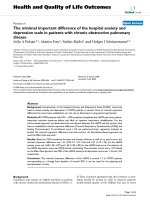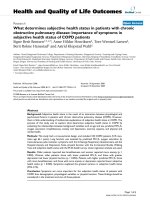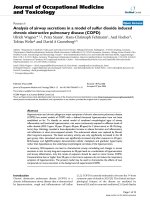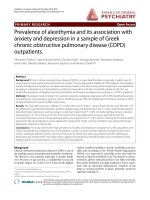Remark on some clinical, subclinical characteristics of chronic obstructive pulmonary disease patients operated lung volume reduction surgery
Bạn đang xem bản rút gọn của tài liệu. Xem và tải ngay bản đầy đủ của tài liệu tại đây (96.02 KB, 6 trang )
Journal of military pharmaco-medicine no7-2019
REMARK ON SOME CLINICAL, SUBCLINICAL
CHARACTERISTICS OF CHRONIC OBSTRUCTIVE PULMONARY
DISEASE PATIENTS OPERATED LUNG VOLUME
REDUCTION SURGERY
Le Minh Phong1; Nguyen Truong Giang2; Ta Ba Thang3
SUMMARY
Objectives: To comment some clinical, subclinical characteristics of chronic obstructive
pulmonary disease patients undergoing lung volume reduction surgery. Subjects and methods:
31 patients, who were exactly diagnosed with chronic obstructive pulmonary disease
undergoing lung volume reduction surgery, were examined and estimated some clinical and
subclinical characteristics. Results: The average age was 66.16 ± 5.62, group of age 60 - 69
accounted for the highest percentage (41.94%). Walking distance of 6 minutes was 293.90 ±
70.79 m. CAT score was 19.00 ± 6.06. The number of patients with CAT score ≥ 10 was
83.87%. mMRC score was 2.35 ± 0.98. Therein, those who had mMRC ≥ 2 accounted for
77.42%. Lung function parameters were TLC: 140.61 ± 21.03% predicted, VC: 87.90 ± 21.91%
predicted, FVC: 85.77 ± 20.00% predicted, FEV1: 52.00 ± 18.71% predicted, Gaensler: 56.13 ±
15.41, PEF: 50.87 ± 15.82% predicted, MVV: 50.42 ± 20.59%, strongly decreased to severe
obstruction of airway that caused alveoli stasis in chronic obstructive pulmonary disease
patients with severe emphysema. Average emphysema score was 2.67 ± 0.83, most of patients
were in level 4 of emphysema (45.16%).
* Keywords: Chronic obstructive pulmonary disease; Lung volume reduction surgery;
Clinical, subclinical characteristics.
INTRODUCTION
Chronic obstructive pulmonary disease
(COPD) - a common, preventable and
treatable disease is characterized by
persistent airflow limitation that is progressive
and associated with an enhanced chronic
inflammatory response in the airway and
the lung to noxious particles and gases.
Outbreak and comorbidities contribute to
the overall severity in individual patients
[3, 9].
According to GOLD’s report (2019),
COPD is currently ranked the 4th among
the causes of death worldwide, it is
estimated that by 2020 it will be ranked
the 3rd among these causes. In 2012 alone,
more than 3 million people died from COPD,
1. 175 Military Hospital
2. Vietnam Military Medical University
3. 103 Military Hospital
Corresponding author: Le Minh Phong ()
Date received:06/07/2019
Date accepted: 26/08/2019
128
Journal of military pharmaco-medicine no7-2019
accouting for 6% of all deaths worldwide
[9]. In Vietnam, in 2010, the study by
Nguyen Thi Xuyen performed on 25,000
subjects aged 15 and above, in 70
locations of 48 provinces through the
country showed that the rate of COPD in
the whole country was 2.2%, in which
3.4% for men, 1.1% for women, mostly in
the age group of 40 and above (4.2%) [5].
Lung volume reduction surgery (LVRS) is
a surgical method that removes
emphysema, increases the elasticity of
the less damaged lung, to improve function,
reduce dyspnoeas, and increase the
mobility of patients [9, 11]. Although this is
considered a safe and effective treatment,
not many facilities in Vietnam can implement
this technique, and research topics on
LVRS in Vietnamese patients are still
limited. We carried out this study with the
aims: Remark some clinical and subclinical
characteristics of COPD patients, who have
indications for LVRS.
SUBJECTS AND METHODS
1. Subjects.
31 male patients were diagnosed with
COPD combined with severe emphysema
underwent LVRS in the Department of
Thoracic Surgery, 103 Military Hospital
from 2013 to 2018.
* Selection criteria:
- Patients diagnosed with COPD
according to GOLD's criteria (2018) [8].
- Criteria for selecting patients with
LVRS according to NETT (2011) [10].
* Exclusion criteria:
- Exclusion criteria for patients with
LVRS according to NETT (2011) [10].
Excluded subjects were patients with
other respiratory diseases (pulmonary
tuberculosis, cancer, bronchial asthma...),
patients with contraindications to respiratory
function test (new heart stroke, pulmonary
embolism, pneumothorax, severe heart
failure, limited cognitive awareness), or
patients refused to join the research group.
2. Methods.
The cross-sectional descriptive study
of clinical and subclinical characteristics
of severe COPD patients undergoing
LVRC.
CAT score were calculated based on
CAT questionnaires (COPD Assessmnet
Test) according to GOLD 2015, including
8 questions serveys on the scale of
cough, sputum, dyspnea, chest pain,
activity, social communication, sleep,
health, each sentence was scored from 0
- 5 points. The overall average score was
calculated by summing of the score of
8 questions. The mMRC score was
calculated based on the mMRC
questionnaires of GOLD 2015 according
to the degree of dyspnea, the score was
given from 0 - 4 points. The level of
emphysema was calculated based on the
area of emphysema region 0%: 0 point;
< 5%: 0.5 point; 5 to < 25%: 1 point; 25 to
< 50%: 2 points; 50 to 75%: 3 points and
≥ 75%: 4 points.
Data processing with software SPSS
22.0 and Excel 2016.
129
Journal of military pharmaco-medicine no7-2019
RESULTS AND DISCUSSION
Table 1: Characteristics of patient by age group.
Age group
n
%
< 60
6
19.35
60 - 69
13
41.94
≥ 70
12
38.71
Sum
31
100
The average age
66.16 ± 5.62
Min - max
55 - 74
100% of research patients were male,
the average age was 66.16 ± 5.62, the
age group of 60 - 69 accounted for the
highest proportion (41.94%). The youngest
and the oldest subjects were 55 and 74,
Our results were consistent with the
study by Dao Ngoc Bang (2019) with
the average age of COPD patients of
65.80 ± 6.96, the age group had the
highest percentage was 60 - 69 (45.45%)
[1]. The results of Nguyen Huy Luc also
showed that a high rate in men with age
group > 50 (92%) [2]. The study by Hruna
Akane et al (2010) showed average age
of 68.7 ± 7.0, with a male/female ratio
was 15.7/1 [6].
Table 2: Clinical characteristics.
Characteristics
X ± SD
Min
Max
6-minute walk test (m)
293.90 ± 70.79
197
440
BMI (kg/m )
2
20.46 ± 3.03
15.24
29.04
CAT
19.00 ± 6.06
8
27
mMRC
2.35 ± 0.98
1
4
- 6-minute walking test: 293.90 ± 70.79 m
was consistent with Dao Ngoc Bang’s
study (2019) (302.82 ± 59.33 m) [1], and
Frank C. Sciurba (333.9 ± 87.4 m) [7].
- BMI of research group was
20.46 ± 3.03 kg/m2, the highest and the
lowest values were 29.04 and 15.24,
respectively.
- The result of our study was suitable
to the study by Dao Ngoc Bang (2019)
130
(18.26 ± 2.46 kg/m2), and Haruna et al
(2010) (21.4 ± 3.0 kg/m2) [1, 6].
- The average mMRC score in whole
study population was 2.35 ± 0.98 points,
the number of patients with mMRC
≥ 2 points was 77.42%.
- The average CAT score of the study
group was 19.00 ± 6.06, of which the
number of patients with a CAT score ≥ 10
points was 83.87%.
Journal of military pharmaco-medicine no7-2019
According to the study by Dao Ngoc
Bang (2019), the CAT score was 19.38 ±
3.26 points, and mMRC was 2.38 ± 0.84
points. According to Do Quyet and
Nguyen Thi Thu Ha (2010), the average
CAT score was 18.59 ± 4.66 points [1, 4],
the results also showed similarities with
the results of our research.
Table 3: Characteristics of lung ventilation parameters.
Respiratiry parameters
X ± SD
Min
Max
TLC (% predicted)
140.61 ± 21.03
108
227
VC (% predicted)
87.90 ± 21.91
49
144
FVC (% predicted)
85.77 ± 20.00
43
133
FEV1 (% predicted)
52.00 ± 18.71
23
106
Gaensler
56.13 ± 15.41
14
87
PEF (% predicted)
50.87 ± 15.82
22
82
MVV (% predicted)
50.42 ± 20.59
22
104
- Results of our study on respiratory
function tests showed TLC of 140.61 ±
21.03% predicted, the result was consistent
with the research result of Dao Ngoc Bang
(2019), who reported TLC of 140.67 ±
26.17% predicted [1].
- The average value of VC and FVC of
the research group decreased, in which
FVC decreased more than VC. The
maximum exhaled volume in the first
second (FEV1) was significantly reduced:
An average of 52.00 ± 18.71% predicted.
- PEF and Gaensler indexes decreased
significantly to 50.87 ± 15.82% predicted
and 56.13 ± 15.41% predicted, respectively.
These results were consistent with the
level of severe airway obstruction causing
alveolar airway obstruction in COPD patients
with severe emphysema.
- Other parameters included FVC, FEV1,
Gaensler, PEF, MVV were higher than
those of Dao Ngoc Bang (2019), FVC:
64.18 ± 14.87% predicted, FEV1: 35.02 ±
13.22% predicted, PEF: 31.20 ± 14.22%
predicted, MVV: 30.88 ± 12.25% predicted
[1]. But they were lower than the study by
Nguyen Huy Luc on FEV1 parameter, type
BB: 53.80 ± 6.86% predicted, type PP:
65.41 ± 15.44% predicted, and parity
similarity Gaensler (type BB: 47.07 ± 6.41;
type PP: 58.84 ± 12.12) [2]. The differences
in above results were probably due to the
differences in disease stages of subjects
selected for the study, but they generally
showed a significant reduction in respiratory
parameters.
131
Journal of military pharmaco-medicine no7-2019
Table 4: Emphysema characteristics and grading on computerized tomography.
Characteristics
X ± SD
Emphysema score
2.67 ± 0.83
Grade
n
%
Level 2
5
16.13
Level 3
12
38.71
Level 4
14
45.16
31
100
Sum
The average emphysema score of the research group on computerized tomography
was 2.67 ± 0.83, of which mainly patients with level 4 emphysema (45.16%). The study
by Dao Ngoc Bang (2019) also gave the emphysema score equivalent to 2.76 ± 0.48,
but the level of emphysema, severe level (45.45%), the very severe level (51.52%)
were higher than our research [1].
CONCLUSION
Through a study of 31 patients, we had
some comments as the following:
- The average age was 66.16 ± 5.62,
the lowest and highest ages were 55 and
74, respectively.
- The average mMRC score of research
group was 2.35 ± 0.98 points, therein, the
percentage of patients with mMRC score
≥ 2 accounted for 77.42%. The average
CAT score was 19.00 ± 6.06, in which the
proportion of CAT score ≥ 10 was 83.87%.
- The maximum exhaled volume in the
first second (FEV1) dramatically reduced,
as measured of 52.00 ± 18.71% predicted.
PEF, Gaensler indexes were significantly
decreased to 50.87 ± 15.82% predicted
and 56.13 ± 15.41% predicted, respectively.
These results are consistent with the
level of severe airway obstruction causing
alveolar airway obstruction in COPD patients
with severe emphysema.
132
- Average emphysema score of research
group on computerized tomography was
2.67 ± 0.83, in which the level 4 of
emphysema accounted for a higher rate
of 45.16%.
REEFERENCES
1. Dao Ngoc Bang. A study on the
efficiency of bronchoscopic lung volume
reduction with one-way valves in patients with
chronic obstructive pulmonary disease. Medical
Doctoral Thesis. Vietnam Military Medical
University. 2019.
2. Nguyen Huy Luc. A study of pulmonary
ventilation characteristics and standard X-ray
images of the body and disease stages in
patients with chronic obstructive pulmonary
disease outbreak. Journal of Practical Medicine.
2010, 4 (714), pp.26-29.
3. Nguyen Huy Luc. Respiratory disease.
People's Army Publishing House. 2012,
pp.41-60.
4. Do Quyet, Nguyen Thi Thu Ha. Results
of using CAT questionaires to assess the heath
Journal of military pharmaco-medicine no7-2019
status of patitents with chronic obstructive
pulmonary disease. Journal of Practical
Medicine. 2010, 12 (745), pp.53-56.
5. Nguyen Thi Xuyen, Dinh Ngoc Sy,
Nguyen Viet Nhung et al. A study on the
situation of chronic obstructive pulmonary
disease in Vietnam. Journal of Practical
Medicine. 2010, 2 (704), pp.8-11.
6. Akane Haruna et al. CT-scan findings of
emphysema predict mortality in COPD. Chest.
2010, 138 (3), pp.635-640.
7. Frank C. Sciurba et al. A randomized
study of endobronchial valves for advanced
emphysema. The New England Journal of
Medicine. 2010, 363 (13), pp.1233-1244.
8. Global Initiative for Chronic Obstructive
Lung Disease. Global Strategy for the diagnois,
management and prevantion of
obtructive pulmonary disease. 2018.
chronic
9. Global Initiative for Chronic Obstructive
Lung Disease. Pocket guide to COPD
diagnosis, management, and prevention
(a guide for health care professionals 2019
edition). 2019.
10. Francis Cordova Gerard J. Criner,
Alice L. Sternberg, Fernando J. Martinez. The
National Emphysema Treatment Trial (NETT)
Part II: Lessons learned about lung volume
reduction surgery. American Journal of
Respiratory and Critical Care Medicine. 2011,
184, pp.881-893.
11. Eberhardt R. Gompelmann D, Herth F.
Endoscopic lung volume reduction. Ann Am
Thorax Soc. 2013, 10 (6), pp.657-666.
133









